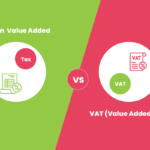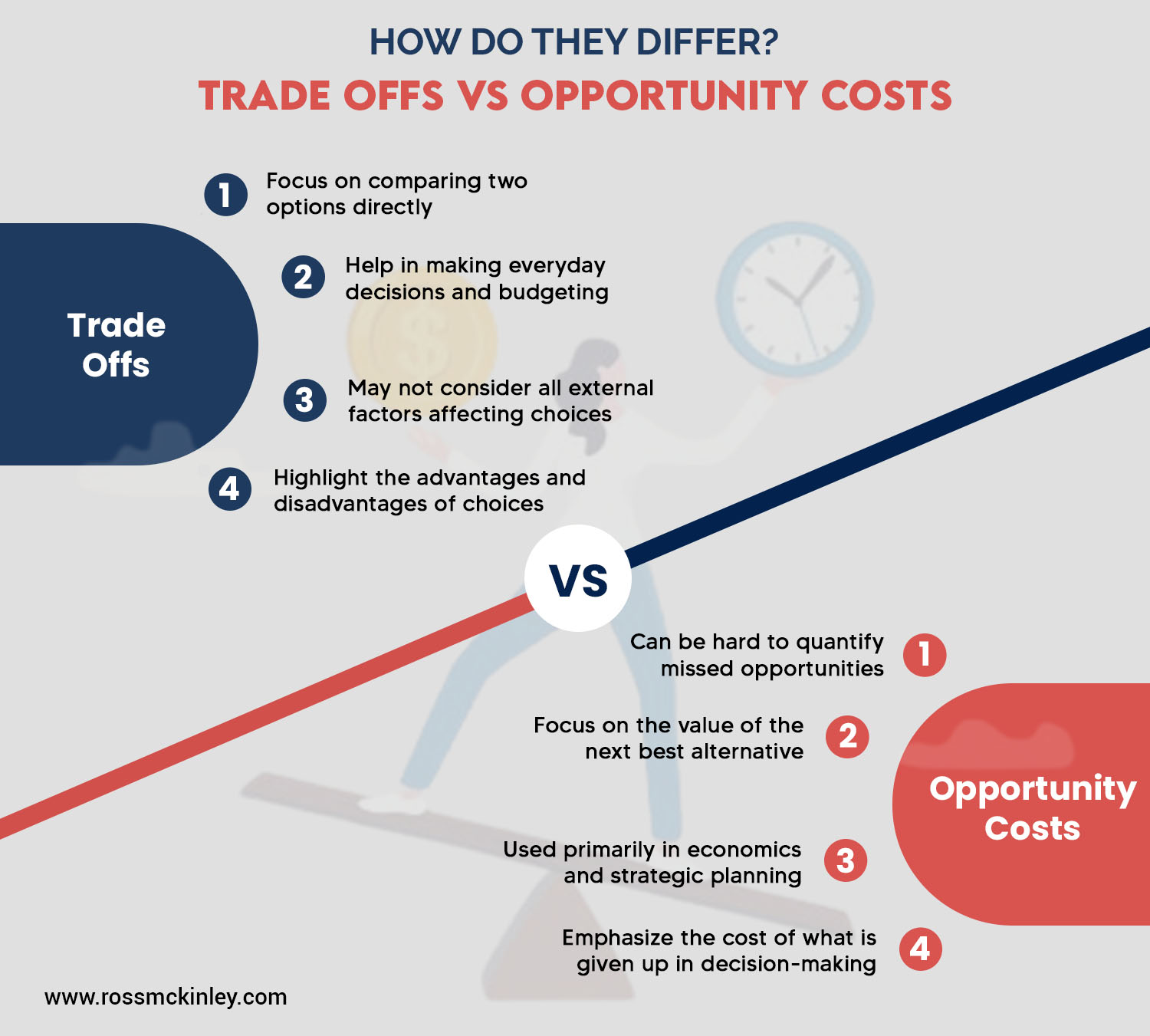
Tax on Value Added vs VAT: How Are They Different?
November 11, 2024
Retained Profit Advantages and Disadvantages
November 13, 2024Trade-offs vs Opportunity Costs: Are They Different?

Trade-offs and opportunity costs are common concepts in economics and decision-making. Though they seem similar, they are different in many ways. A trade-off involves sacrificing one option to obtain something else.
Opportunity cost, on the other hand, is the value of what you miss out on by not choosing the next best option. Both concepts help individuals and companies make smarter decisions, use resources effectively, and understand how their decisions affect them in the long term.
This blog will explore the differences between trade-offs vs opportunity costs. Let’s start by defining both to better understand how these concepts affect our choices every day!

Table of Contents
What Is a Trade-off?
A trade-off occurs when you give up one thing to gain another. It means choosing between two options, where selecting one means losing the other. Trade-offs are a part of everyday life, and they happen in many situations, such as shopping or making plans.
When you have limited resources, like time or money, you must choose one and understand that you cannot have everything.
Trade-offs are also important in business. Companies often have to balance their resources to achieve their goals effectively. Overall, trade-offs are essential for making informed decisions in daily life and business.
Examples of Trade-off
There are many examples of trade-offs in everyday life. For example, if you want to take a vacation but have a low budget, you might need to cut back on dining out or shopping for new clothes to save enough money.
In this case, you are making a trade-off between enjoying those expenses now and saving for your vacation. Essentially, you are sacrificing some of your current spending to save up for a fun experience later.
What Is an Opportunity Cost?
Opportunity cost is an important concept in economics that relates to decision-making. It refers to what you let go and what you choose over another. When you choose, you miss out on the next best alternative, representing your opportunity cost.
Every decision carries an opportunity cost, whether it involves spending money, using time, or applying effort. However, the cost will vary depending on the choices you make and their pros.
When you’re aware of opportunity costs, you can make smarter choices that align with your goals and priorities.
Examples of Opportunity Cost
Opportunity cost is an important concept in economics that deals with decision-making. When you have two choices, the opportunity cost is what you give up while selecting one. For example, when choosing among two, you must analyze the benefits of each.
If you decide to pursue further education, the opportunity cost might be the income you miss from not working. Conversely, if you choose to work, the opportunity cost is the knowledge and experience you’ll fail to achieve.
Trade-Offs vs Opportunity Costs- Differences
Are you struggling to tell the difference between trade-offs vs opportunity costs? Don’t worry! We’ll explain their differences clearly later and here are some helpful points below to make it easier for you to understand.
| Trade-offs | Opportunity Costs |
| Focus on comparing two options directly | Focus on the value of the next best alternative |
| Help in making everyday decisions and budgeting | Used primarily in economics and strategic planning |
| May not consider all external factors affecting choices | Can be hard to quantify missed opportunities |
| Highlight the advantages and disadvantages of choices | Emphasize the cost of what is given up in decision-making |
Differences Between a Trade-off vs an Opportunity Cost
Understanding the differences between trade-offs and opportunity costs is important to avoid confusion. Many people mix these terms so here are some major differences between trade-offs vs opportunity costs.
Importance of Trade-off vs. Opportunity Cost
Trade-offs are essential for making informed decisions as they help individuals and organizations analyze their choices, pros and cons. For example, when deciding how to spend time, you may choose between studying or hanging out with friends. Also, you’ll have to face drawbacks and benefits whichever choice you make.
Opportunity costs also help you understand your choice’s worth. They allow you to compare the cost of their chosen option with the available alternatives. When you pick one option, you forgo another, which can also have value.
Both trade-offs and opportunity costs guide better decision-making. Recognizing their importance allows for smarter resource use and thoughtful choices in everyday life.
Difference in Focus
Trade-offs focus on comparing two options directly, so you must analyze the advantages and disadvantages of possible choices. For example, when shopping, you may compare two different products. This helps determine which option provides more value for your money.
Opportunity costs focus on what you lose when selecting one thing and highlight the value of the next best alternative. For example, if you choose to buy a video game, you may miss the chance to buy a book.
Understanding these differences in focus can simplify complex decisions and allow for clearer evaluations of the choices at hand.
Uses of Trade-offs vs. Opportunity Cost
Trade-offs are often used in everyday decision-making and budgeting. They help individuals prioritize their options based on available resources. For example, if you want to save money for a new bike, you might cut back on snacks. This decision showcases the process of weighing choices.
Opportunity costs are used in economics and strategic planning. They guide organizations in evaluating the potential benefits of different options. For example, a business might decide between investing in new technology or hiring more staff.
Understanding opportunity costs helps clarify which option might lead to better outcomes. Recognizing how each concept is used can improve decision-making and encourage individuals and businesses to allocate their resources wisely.
Limitation of Tradeoff and Opportunity Cost
Trade-offs come with limitations that can affect decision-making. They may not consider all external factors that impact choices. For example, one might overlook quality or satisfaction when deciding how to spend money. This oversight can lead to wrong decisions.
Opportunity costs also have limitations, especially when measuring missed opportunities. They focus on the cost of what is given up, which can be hard to quantify. Sometimes, the true value of a lost alternative may not be clear.
As a result, it becomes challenging to assess the impact of decisions accurately. Being aware of these limitations promotes more thorough evaluations. It encourages deeper analysis of decisions in personal and professional settings.
Conclusion
Trade-offs vs opportunity costs are important concepts in decision-making. They help individuals and businesses make informed choices by carefully weighing their options.
When making decisions, consider the benefits and drawbacks of each choice. List what you might gain and what you might lose. This approach will guide you in selecting the best option for your needs. It’s also helpful to talk to others who have faced similar choices.
Sharing experiences can provide valuable insights. Always remember that making thoughtful decisions leads to better outcomes. With practice, you will become a more confident and skilled decision-maker.
